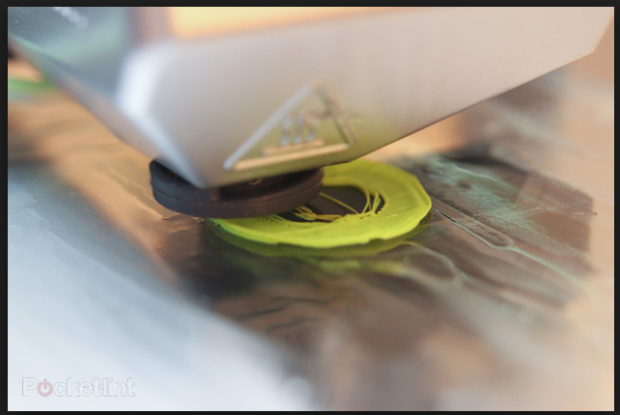 It was just earlier this month that we reported on a company called Aprecia Pharmaceuticals and their new FDA-approved 3D printed ZipDose tablets. This news was quite significant, as it was the first time that the FDA approved a 3D printed drug.
It was just earlier this month that we reported on a company called Aprecia Pharmaceuticals and their new FDA-approved 3D printed ZipDose tablets. This news was quite significant, as it was the first time that the FDA approved a 3D printed drug.
 Now one Berlin, Germany-based company, called ‘3D Printer Drug Machine‘, has decided to try and take things one step further. They plan to do so with the creation of a 3D drug printer, and special custom drug delivery polymer filaments.
Now one Berlin, Germany-based company, called ‘3D Printer Drug Machine‘, has decided to try and take things one step further. They plan to do so with the creation of a 3D drug printer, and special custom drug delivery polymer filaments.
“We generally use traditional and custom filament combined for the purpose,” Mahmudur Rahman, Founder and CEO of 3D Printer Drug Machine tells 3DPrint.com. “We modify it to be edible and also make it dissolve in a certain time period. We also look at the toxicity of the materials and whether they give any unwanted effect.”
Rahman, who is a pharmacist of 9 years, tells us that his company is making their unique 3D printers available in kit form for just $150-$300, with plans to eventually sell various forms of drug tablet polymers for a range of different prices. He has just launched an Indiegogo campaign in order to help fund the further development of the various polymers and the printers themselves, in order to bring an entire 3D printed customized drug prescription system into existence.
Rahman’s 3D drug printer, according to him, is capable of 3D printing an accurate dose of drugs, while also providing for a ton of savings. At the same time though, he says his system is able to provide a more custom dosage to patients rather than just simply the standard doses that we are used to seeing today.
“Various types of patient[s] need various types of dose[s],” Rahman explains. “Suppose some patient need[s] 500 mg Paracetamol for their therapy, but [an]other need[s] 450 mg [of the] same drug, as their body weight and size is different. So dose adjustment is very important. The traditional pharmaceutical companies only make doses with 500 mg or 1000 mg, but if we print the drug, then we can make the accurate dose, according to patient’s need.”
 Certainly Rahman, and his company will have their work cut out for them when it comes to gaining FDA approval — a lengthy process which is sure to have plenty of obstacles along the way. According to his plan, every patient will have their own account in a database driven system which allows them to order a printed drug as needed. A qualified pharmacist will then ensure that the drug being ordered is correct, safe, and official before determining the exact dosage required. This drug could then be 3D printed on one of Rahman’s machines.
Certainly Rahman, and his company will have their work cut out for them when it comes to gaining FDA approval — a lengthy process which is sure to have plenty of obstacles along the way. According to his plan, every patient will have their own account in a database driven system which allows them to order a printed drug as needed. A qualified pharmacist will then ensure that the drug being ordered is correct, safe, and official before determining the exact dosage required. This drug could then be 3D printed on one of Rahman’s machines.
“For example, if you print a drug like an antibiotic, then we will use a certain type of polymer,” Rahman explains to us. If you use an antipyretic or analgesic drug then we use anther polymer. For example, paracetamol can be used for fever, ciprofloxacin can be used as an antibiotic and other types of drug which we are now testing can be used for various diseases according to their action.”
Rahman says that the difficult part is devising the formulas for the printed drug filament. Obviously you can’t simply print drugs using PLA or ABS plastics, which are used one on most desktop 3D printers. Instead the printed material will be made up of materials such as Avicel, Ludipress, and Povidone, in some sort of combination in order to make the filaments.
“It’s not an easy process to make the filaments,” he tells us. “It needs a proper ratio and proper method to make the right material and several drugs also need several excipient to make the filament.”
It should be interesting to keep an eye on Rahman’s company, whether or not his Indiegogo campaign is funded or not. The future definitely looks promising when considering the idea of 3D printing custom drug doses, but is the world quite yet ready for such technology? Only time will tell.
Subscribe to Our Email Newsletter
Stay up-to-date on all the latest news from the 3D printing industry and receive information and offers from third party vendors.
Print Services
Upload your 3D Models and get them printed quickly and efficiently.
You May Also Like
Formlabs Fuse 1+ 30W: Small SLS Printer, Massive Impact
Disclosure: With Formlabs permission I was able to sell my 4L and use that to help with the purchase of the Fuse 1+ and Fuse Sift. Aside from allowing me...
ASTM International Works with UK MoD on America Makes Project
The UK Ministry of Defense (MoD) will work with ASTM International on a $1.1 million project to let it work in closer concert with the US Department of War (DoW)....
3D Printing News Briefs, January 15, 2026: Project Call, Sports Medicine, Aluminum Alloy, & More
In today’s 3D Printing News Briefs, America Makes announced the winners of a $1.1 million Project Call, Austal USA named a new Vice President for Business Development and External Affairs,...
UK Government Partnership to Develop 3D Printed Metal Alloys for Nuclear Fusion
The UK Atomic Energy Authority (UKAEA), a government-funded research organization, has demonstrated a persistent interest in developing metal additive manufacturing (AM) materials for nuclear fusion applications, including multiple phases of...





























